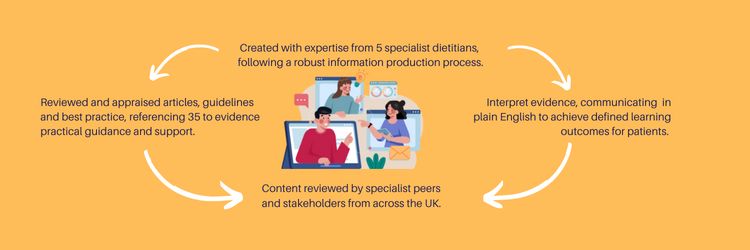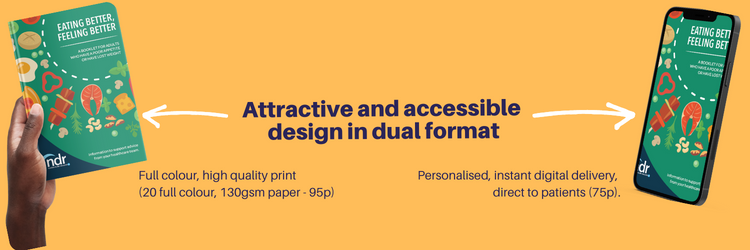What's the value of a diet-sheet?

Published: 19.10.22
Malnutrition Awareness Week 2022 (10-17/10/22) demonstrated the vital importance of preventing and managing the risks of malnutrition. The clinical causes of malnutrition, the social and environmental issues exacerbating it, and routes to limit and resolve it, are wide and varied. This has made us reflect on what we do, how we do it and its potential impact.
In recent parliamentary debates on this issue, it was estimated that malnutrition costs the health service £23.5 billion and treating a person with malnutrition will cost over 3 times more than one without.1 Furthermore, looking at specific risks relating to clinical issues such as dysphagia, 51% of people with dysphagia are at risk of malnutrition with up to 75% suffering from dehydration.2 So what are the costs of trying to support people meet their nutritional needs and maintain (or increase) their quality of life? Can an impact be achieved for under £1?
NDR-UK has a range of patient information resources to provide food first approaches to help people increase their nutritional intake to meet their nutritional needs through illness, recovery and frailty. We all know, never more so than now, that value for money is essential. With everyone trying to make efficiencies, the costs, benefits, risks and impacts of patient care have never been in greater focus.

‘Eating Better, Feeling Better’ is one of our most popular resources with over150,000 copies distributed since 2004. In line with evidence and practice, it has been reviewed and updated several time, and earlier this year, went through a full review and redesign. Using our recognised, robust information production cycle:
- 5 specialist dietitians critically appraised evidence, guidelines and policy
- Evidence was interpreted to communicate practical guidance and messages in plain English to achieve defined learning outcomes for patients
- Comments and feedback were requested and received via open review from stakeholders and networks
- A modern and fresh layout was launched in both print and electronic format.
So what is the cost of these resources?
- 95p for a full colour, 20-page printed booklet or
- 75p for a personalised electronic copy.
These resources enable health professionals to provide practical guidance with a range of suggestions, choices and tips to increase intake and help improve health, increasing quality of life and reducing costs of ONS and hospital stays. They avoid services duplicating effort to prepare, produce and sustain guidance material and ensure that specialists can focus their time, energy and resource directly on patient care. They also give generalists and non-specialists assurance and confidence that the information is up-to-date, evidenced and written by relevant experts.
In practice, it is impossible for NDR-UK to measure the impact – financial or otherwise - of this resource on patient health outcomes. However, we are assured by the dietitians and other health professionals who have returned to this title, time and time again over the years, that it does indeed provide a productive and very efficient way to provide support to those at risk of, or trying to address current experiences of, malnutrition. It may only be a piece of the puzzle, but issued by a health professional to tailor guidance and follow up based on individual needs/preferences, this resource is a valuable tool for services throughout the UK.
As we all struggle to achieve ever greater cost-efficiencies, enabling and supporting personal decision-making and ownership of health improvements should be encouraged. We therefore firmly believe that at a unit cost of less than £1 per patient, this specialist resource is an affordable tool for health bodies, to contribute to the ways in which they address the incidence and consequences of malnutrition – a value-for-money investment which educates and enables recipients (and/or their carers) to take greater control and contribute more effectively to improving their health and well-being.
If you would like to view a sample, visit the shop (https://www.ndr-uk.org/item/46/FoodFortification/Eating-Better-Feeling-Better.html). To arrange a demonstration on how to issue this (or any of our resources) electronically, please email me.
1 Malnutrition and the NHS Volume 712: debated on Monday 25 April 2022, https://hansard.parliament.uk/Commons/2022-04-25/debates/9BA607B2-C2C7-4A70-B8C4-8BDC148B6BE9/MalnutritionAndTheNHS [accessed 18/10/22]
2 Leibovitz A, Baumoehl Y, Lubart E, et al. 2007, González-Fernández M et al. and 2013 Carrion S et al. 2017 cited from Holdaway and Smith 2019, Dysphagia A HEALTHCARE PROFESSIONAL FACT SHEET, https://www.malnutritionpathway.co.uk/dysphagia.pdf [accessed 18/10/22]
